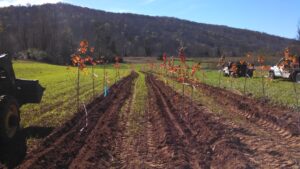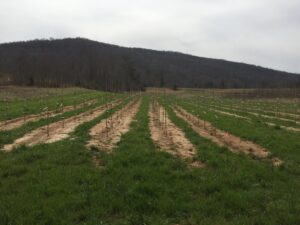2016 Annual Report for OS14-084
Incorporating a Cover Crop into Field Grown Nursery Production to Manage Flatheaded Appletree Borer with the Simultaneous Benefit of Improved and Sustainable Weed Management
Summary
The purpose of this project is to investigate the use of cover crops to prevent flatheaded appletree borer (FAB), Chrysobothris femorata (Olivier) (Coleoptera: Buprestidae) attacks on maple trees and suppress competitive weeds in tree rows and middles. Flatheaded appletree borer has long been identified as a significant economic pest in orchards, nurseries and urban landscapes. Larval tunneling by FAB can girdle small trees, causing rapid decline of economically important hosts, with some nurseries reporting infestation rates of 30% or more on susceptible tree species. These infested trees can be killed outright by trunk girdling or rendered unmarketable due to borer damage. In production nurseries, red maples are one of the most problematic trees for FAB attacks in Tennessee. Frequency of FAB attacks in nurseries varies for a number of reasons, including timing of protective sprays, size of trees at planting, site conditions, and localized borer populations. Transplant stress alone does not explain attack frequency because FAB damage continues to be added to nursery blocks over time. Since any FAB damage ruins the marketability of a nursery tree, the economic threshold for damage is essentially zero. Therefore, treatments or cultural practices that prevent FAB damage are very important to nursery growers to prevent economic losses.
Our preliminary research suggests that the presence of a winter cover crop may be a favorable option for nursery growers, acting as (1) a barrier to FAB oviposition in the spring and early summer, (2) an aid to preventing leaching of imidacloprid from the root zone of the trees and (3) as a natural suppression system for opportunistic weed species. We therefore propose a systems approach to in-field nursery tree production by incorporating a winter cover crop system combined with optimized pesticide use in order to simultaneously maximize FAB control and plant growth while minimize crop damage, weed competition and insecticide runoff.
Objectives/Performance Targets
For the performance period described here, objectives were to:
- Establish 2015 winter cover crop
- Take initial maple tree measurements
- Transplant trees into the field
- Stake and fertilize trees
- Train masters student(s) in imidacloprid ELISA techniques
- Begin spring plot evaluations
- Treat insecticide plots
Accomplishments/Milestones
 Maple field plot establishment, Fall 2015
Maple field plot establishment, Fall 2015
In October of 2015, a mix of wheat and crimson clover were established in a half acre field plot. Trees were measured (height, caliper at 6 in) and transplanted dormant in November into the field plots using a tractor with transplanter attachment. Plot rows were overseeded after transplanting of trees since disturbed soil caused severe disruption of cover crop. In early spring, the cover crop plots were evaluated and it was determined that the fall cover crop failed to recover at adequate densities in the tree rows (tree middles had good establishment of wheat and clover). In addition to field work, students participating in the project were trained on how to collect maple leaves and process them for imidacloprid analysis by ELISA.

- Late Winter/Early Spring 2016, Low Row Cover Establishment
Since the primary goal of the project is to block FHAB oviposition at the base of the trees, the tree rows required an additional application of a spring cover crop. Annual ryegrass was chosen based on its quick establishment, spring growth and maximal height in late spring/early summer (2-3 ft) required to block preferred oviposition sites and was applied on March 9th. Annual ryegrass will also senesce naturally in summer heat. The results of this initial fall cover seeding indicate that standard methods of winter cover cropping and fall nursery transplant timing are not compatible if the goal is to have cover established in the tree rows. While it is possible that earlier plantings of cover crop may prove more resilient, the amount of soil disruption caused by the trasplanter is a serious obstacle. Planting into fall seeded winter wheat/clover for the purpose of maintaining cover in tree middles is compatible with current transplanting methods. It is more likely that in Year 1 of field production, a combination of winter cover for middles and early spring cover for tree rows will be required if the goal is protection from FHAB.
Trees were staked and fertilized on March 8th. Pre and post-emergent herbicides were applied on March 25th to the tree rows in control treatments. Row middles were mowed on March 29th in all plots and will be maintained bi-weekly. Annual ryegrass has begun to establish. As of April 1st, measurements of soil moisture and temperature in rows and middles in all plot treatments have begun. In addition, tree trunk temperatures are also being recorded at the preferred site of FHAB oviposition (SW side of each tree at 20 cm). These measurements will be repeated bi-weekly through June. On March 28th, bee bowls were deployed and will be set out monthly at the center of each plot to evaluate pollinator presence in each treatment and correlated with the presence of flowering weeds, trees and cover crops. Beginning in April, cover crop density/coverage and weed penetration will be evaluated bi-monthly in all plots in tree rows and middles. Imidacloprid drench application to insecticide treated plots is also scheduled for the week of April 10th.
Impacts and Contributions/Outcomes
During the performance period, we established that: (1) planting trees into a winter cover crop is unlikely to protect them from FHAB due to poor recovery of wheat/clover from soil disruption by the transplanter and (2) transplanting trees into fall seeded cover crops can be a successful method for establishing row middle covers.
Collaborators:
119 Eagle BLVD
McMinnville, TN 37378
Office Phone: 9316684351
Research Horticulturalist
USDA-ARS
472 Cadillac Lane
McMinnville, TN 37110
Office Phone: 9318155144
Reseach Associate Professor
Tennessee State University
472 Cadillac Lane
McMinnville, TN 37110
Office Phone: 9318155145